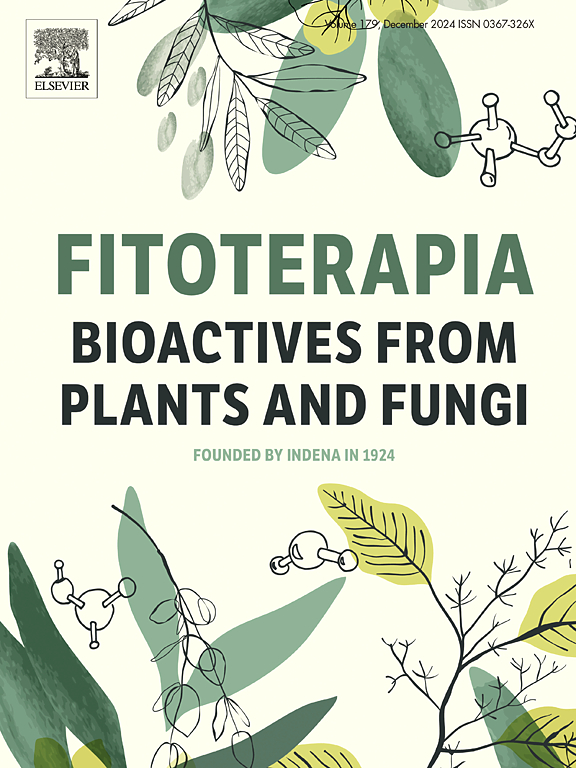新含氧倍半萜类化合物及其抗病毒抗炎活性的体外评价。
IF 2.6
3区 医学
Q3 CHEMISTRY, MEDICINAL
引用次数: 0
摘要
凤梨属是一个单型属,含有凤梨属,俗称橄榄灌木。传统上它被用于治疗疱疹、咳嗽、感冒、炎症、溃疡和伤口。因此,本研究采用体外抗炎和抗病毒活性的方法对其进行了研究。此外,对非极性组分进行了植物化学研究,以确定负责活性的化合物。通过测定fMLF/ cb诱导的人中性粒细胞对超氧阴离子生成和弹性蛋白酶释放的抑制作用来评估其抗炎活性。测定其对单纯疱疹病毒1型(HSV-1)和甲型肝炎病毒(HAVH10)的抗病毒活性。二氯甲烷部位抑制超氧阴离子生成和弹性蛋白酶释放的IC50分别为5.21和6.72 μg/mL,抗炎活性最强。对HSV-1和HAVH10的EC50分别为332和290 μg/mL。总提取物对HSV-1和HAVH10的EC50分别为214和190 μg/mL,具有良好的抗病毒活性。通过植物化学分析,分离出3种含氧倍半萜;脱氢表ingaione(1)、10,11-脱氢肌孔酮(2)及新分离化合物;1,2,15三氢-1,15-二甲氧基- 2,3 -二羟基脱氢氢酮(3)。对二氯甲烷组分进行植物化学研究,分离出新的外旋异构体1R/ 1s -1-甲氧基-1-氢-15-氧脱氢aione(4)和(5)。结果表明,非极性部分具有抗炎和抗病毒活性,可能与主要含氧倍半萜有关。本文章由计算机程序翻译,如有差异,请以英文原文为准。

New oxygenated sesquiterpenes from Bontia daphnoides L. leaves and in vitro evaluation of its antiviral and anti-inflammatory activity
Bontia is a monotypic genus containing Bontia daphnoides which is known as olive bush. It was used traditionally for the treatment of herpes, cough, colds, inflammation, ulcers and wounds. Therefore, in this study the anti-inflammatory and antiviral activities of the leaves extract and fractions were measured in vitro. Also phytochemical investigation of the non-polar fractions was done to identify the compounds responsible for activity. The anti-inflammatory activity was assessed by measuring the inhibition of superoxide anion generation and elastase release in fMLF/CB-induced human neutrophils. The antiviral activity was measured against Herpes simplex virus type 1 (HSV-1) and Hepatitis A virus (HAV![]() H10). The dichloromethane fraction showed the most potent anti-inflammatory activity by inhibiting superoxide anion generation and elastase release with IC50 5.21and 6.72 μg/mL, respectively. It showed antiviral activity with EC50 of 332 and 290 μg/mL for HSV-1 and HAV
H10). The dichloromethane fraction showed the most potent anti-inflammatory activity by inhibiting superoxide anion generation and elastase release with IC50 5.21and 6.72 μg/mL, respectively. It showed antiviral activity with EC50 of 332 and 290 μg/mL for HSV-1 and HAV![]() H10, respectively. The total extract showed a promising antiviral activity with EC50 of 214 and 190 μg/mL against HSV-1 and HAV
H10, respectively. The total extract showed a promising antiviral activity with EC50 of 214 and 190 μg/mL against HSV-1 and HAV![]() H10, respectively. Phytochemical investigation of the n-hexane fraction of B. daphnoides resulted in the isolation of three oxygenated sesquiterpenes; dehydroepingaione (1), 10,11-dehydromyoporone (2) and the newly isolated compound; 1,2,15 trihydro-1,15-dimethoxy-2, 3-dihydroxy-dehydrongaione (3). Phytochemical investigation of dichloromethane fraction resulted in the isolation of new epimeric isomers 1R/1S-1-methoxy-1-hydro-15-oxodehydrongaione (4) and (5). From the results, it was concluded that nonpolar fractions of B. daphnoides could exhibit anti-inflammatory and antiviral activities, probably owing to the major oxygenated sesquiterpenes.
H10, respectively. Phytochemical investigation of the n-hexane fraction of B. daphnoides resulted in the isolation of three oxygenated sesquiterpenes; dehydroepingaione (1), 10,11-dehydromyoporone (2) and the newly isolated compound; 1,2,15 trihydro-1,15-dimethoxy-2, 3-dihydroxy-dehydrongaione (3). Phytochemical investigation of dichloromethane fraction resulted in the isolation of new epimeric isomers 1R/1S-1-methoxy-1-hydro-15-oxodehydrongaione (4) and (5). From the results, it was concluded that nonpolar fractions of B. daphnoides could exhibit anti-inflammatory and antiviral activities, probably owing to the major oxygenated sesquiterpenes.
求助全文
通过发布文献求助,成功后即可免费获取论文全文。
去求助
来源期刊

Fitoterapia
医学-药学
CiteScore
5.80
自引率
2.90%
发文量
198
审稿时长
1.5 months
期刊介绍:
Fitoterapia is a Journal dedicated to medicinal plants and to bioactive natural products of plant origin. It publishes original contributions in seven major areas:
1. Characterization of active ingredients of medicinal plants
2. Development of standardization method for bioactive plant extracts and natural products
3. Identification of bioactivity in plant extracts
4. Identification of targets and mechanism of activity of plant extracts
5. Production and genomic characterization of medicinal plants biomass
6. Chemistry and biochemistry of bioactive natural products of plant origin
7. Critical reviews of the historical, clinical and legal status of medicinal plants, and accounts on topical issues.
 求助内容:
求助内容: 应助结果提醒方式:
应助结果提醒方式:


